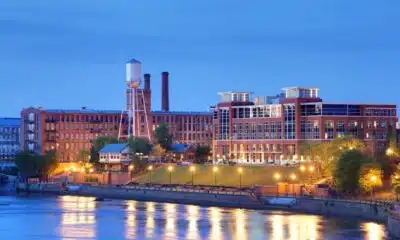News from the South - Louisiana News Feed
Louisiana’s oyster industry is at risk. A new harvesting technique is pitched as a solution.
by Elise Plunk, Louisiana Illuminator
May 19, 2025
GRAND ISLE – Not all jewels have the deep green features of emeralds or sparkle of diamonds. Some tumble from algae-coated cages in a rush of rock and shell, briny water splashing alongside them onto the deck of a boat.
These fine commodities are oysters, grown and harvested just off Louisiana’s coastline in a different way than the traditional seafloor beds that have been farmed for generations.
Cultivated in a string of floating cages instead of on the water’s bottom, Grand Isle Jewels, the umbrella brand for all off-bottom oysters in the barrier island community, are marketed as precious gems of the Gulf Coast.
“You create this craze for a certain item, and everybody’s jumping on it,” said Kirk Curole, owner of Bayside Oysters in Grand Isle.
After retiring from a career in oil and gas, Curole began harvesting off-bottom oysters as a hobby that turned into a small business. He now spends his days on the water, clad in rubber waders and toughened gloves as he pulls his crop from the floating cages.
“It’s the ‘bougie’ oyster. It’s the boutique oyster,” he said. “Everybody wants to try it.”
Louisiana is exploring Grand Isle Jewels as more than just a marketing strategy. The U.S. Army Corps of Engineers lists the state’s strong interest in off-bottom oyster cultivation as a way to help build resiliency into an industry under threat from sediment diversions in its final environmental impact statement for the controversial Mid-Barataria Sediment Diversion project.
Whether this technique can beat back worsening hurricanes, climate change and the impact of sediment diversions is still undetermined.
{ “@context”: “http://schema.org”, “@type” : “ImageGallery”, “id” : “https://lailluminator.com/2025/05/19/louisiana-oyster/”, “url” : “https://lailluminator.com/2025/05/19/louisiana-oyster/” }
An industry at risk
On-bottom culture, where oysters attach to reefs or substrate on the water’s bottom, is and has been the most popular method of oyster harvesting in Louisiana’s waters, fed for centuries by the wealth of nutrients carried down the Mississippi River and into the delta region.
“Oysters here are probably in the best location in this regard because they show very high growth,” said Romain Lavaud, an oyster scientist and researcher at LSU. “They can be harvested within a year, whereas in other parts of their distribution range it can take two to three years.”
But Louisiana’s environment can also be an oyster harvester’s worst enemy. Hurricanes inflict huge damage to oyster reefs, and heavy rains can dilute the salt content of the water, killing oyster crops.
“You’re kind of, like in any agriculture production, at the mercy of environmental conditions,” Lauvaud said.
Farming oysters has always been a gamble, said Peter Vujnovich, a third-generation on-bottom harvester based in Port Sulphur. Oyster farmers can lose big after a storm, he said.
“Mostly you try to protect your house, your boats and the equipment and stuff like that, and the rest is really up to God,” Vujnovich said. “Make the sign of the cross, just hope you don’t get a direct hit.”
Port Sulphur saw large losses to its oyster reefs in 2005 from Hurricane Katrina, which eliminated seeding ground for traditional farmers.
Then, there are sediment diversions, a coastal restoration approach that mimics the natural process of building a delta with silty water from the Mississippi River. There are multiple planned diversions in Louisiana’s Coastal Master Plan to rebuild wetlands that have been diminished through hurricanes, natural subsidence and countless man-made canals.
The Mid-Barataria Sediment Diversion project is one of the more controversial ones because of its likelihood of “major, permanent, adverse impacts” to oyster populations, according to the U.S. Army Corps of Engineers environmental impact statement. It would alter or eliminate vast swaths of habitat in the Barataria basin, with the goal of returning the area to what it looked like before the effects of sea level rise, erosion and subsidence changed it.
But on-bottom harvesters need reefs, and diversions would likely permanently eliminate vast swaths of oyster habitat. The Corps of Engineers’ study for the Mid-Barataria Sediment Diversion suggests the most productive oyster grounds in its basin, Hackberry Bay, “would experience the highest losses,” potentially experiencing “total loss” of habitat.
Gov. Jeff Landry has called for a pause on the nearly $3 billion project, citing in part its impact on the oyster industry.
Seeding off-bottom solutions
The Corps of Engineers has identified off-bottom oyster cultivation as a potential way for the industry to adapt to the threat of sediment diversions. The federal agency has oversight of all coastal restoration projects and acts as a gatekeeper for what’s proposed in Louisiana’s Coastal Master Plan.
Off-bottom farming could “help diversify the oyster industry and add a level of sustainability as the industry adjusts to a changing coast,” specifically in response to the diversion’s impact on salinity, the corps study said.
Off-bottom culture can help with protection against predators and offer a way to harvest in areas without abundant reefs, left stripped after storms. But the key advantage the Army Corps and the state’s Coastal Restoration and Protection Authority cites centers around mobility.
Floating cages could, in theory, be moved in response to a low salinity event such as the opening of a diversion. But harvesters need permission from regulators to store their gear and oysters in different bodies of water from where they’re harvested, and that can take up to 18 months to obtain. Also, the Louisiana Department of Health and the U.S. Food and Drug Administration does not allow oysters to be out of the water for more than 24 hours.
Mobility could also help mitigate hurricane damage even if the oysters have to be jettisoned so the cages could be moved on shore temporarily during a storm.
Curole said even if he loses his crop, it’s worth it to save his expensive equipment and harvest off-bottom again after the storm.
“If a storm is coming, I’m just going to go pick up my equipment, even if I have to dump my oysters out,” he said. “I can oyster next year, or I can oyster in two or three months.”
This works for Curole, whose trailer can haul up to 350 oyster cages, but his business is relatively small. At the scale industry would need, there might not be enough time to relocate all the cages they would use, and the loss could spell doom for a business’ bottom line.
“It has not been demonstrated that gear can be sunk and retrieved cost-effectively or relocated in time to avoid damage and loss of both gear and crop,” Daniel Petrolia, a University of Mississippi agro-ecomomics professor, wrote in a 2023 report on the economic challenges to off-bottom harvesting in Louisiana.
Time is in short supply as hurricanes approach, especially with storms developing and intensifying more rapidly in recent years. Off-bottom oyster operations are already expensive, according to the Petrolia report. He concludes the loss of harvesting gear to a storm could sink an off-bottom oyster harvester’s livelihood indefinitely.
Reliant on subsidies
Petrolia’s report also found that the success of off-bottom oysters in Louisiana relies entirely on state subsidies.
Louisiana began to offer grants for off-bottom harvesters in 2022, starting with $3 million to address the high startup costs
“Although the … grant program can indeed provide a hand up to existing growers, it does distort market signals and may give the impression that economic conditions are better than they actually are,” the report reads. “The eventual disappearance of the [subsidy] program will likely have consequences.”
The report also doesn’t expect “the average small-scale operation” to be profitable, even with funding support from the state. Curole did not receive a grant from the state and said his business is currently profitable, but he represents a smaller set of growers that operate more for supplemental income. True profitability becomes more possible, according to the report, with larger businesses.
Off-bottom cultivation was never pitched as a silver bullet solution for the oyster industry’s future. Louisiana SeaGrant, a federal government-LSU partnership, is responsible for the majority of the off-bottom funding and hatchery support. It paid for Petrolia’s report and stands by the idea that off-bottom culture is meant to supplement rather than replace traditional techniques.
Different off-bottom initiatives continue to support the oyster industry, such as the expansion of hatchery operations that farmers rely on for seed. Further research, such as how to sink and secure cages during hurricanes, and grant money to support it are also needed.
To harvesters like Vujnovich, the survival of the industry doesn’t hinge on a choice between off-bottom or on-bottom cultivation. It’s whether or not these tools will help his industry stand on its own again.
“They’ll always have a few hardcore like me,” he said. “The question is not if it’ll survive; it’s if it’ll flourish again.”
YOU MAKE OUR WORK POSSIBLE.
Louisiana Illuminator is part of States Newsroom, a nonprofit news network supported by grants and a coalition of donors as a 501c(3) public charity. Louisiana Illuminator maintains editorial independence. Contact Editor Greg LaRose for questions: info@lailluminator.com.
The post Louisiana’s oyster industry is at risk. A new harvesting technique is pitched as a solution. appeared first on lailluminator.com
Note: The following A.I. based commentary is not part of the original article, reproduced above, but is offered in the hopes that it will promote greater media literacy and critical thinking, by making any potential bias more visible to the reader –Staff Editor.
Political Bias Rating: Center-Left
This content leans center-left as it focuses on environmental and economic challenges faced by the oyster industry, emphasizing climate change, hurricane impacts, and the consequences of large-scale coastal restoration projects. It highlights concerns about sediment diversions and their potential adverse effects on oyster habitats, while also discussing state subsidies as necessary support for off-bottom cultivation methods. The article reflects an interest in sustainable practices and government intervention to support vulnerable industries, common themes in center-left discourse, but it does so in a balanced, fact-driven manner without overtly partisan language or ideological framing.
News from the South - Louisiana News Feed
How the AcA brought Kandinsky to kindergarten – The Current
SUMMARY: Renée Roberts’ passion for art, inspired by her mother, led her to champion arts education in Acadiana starting in the 1970s. After volunteering with the newly formed Acadiana Arts Council (AcA), she developed Bright New Worlds, placing teaching artists in public schools. Partnering with Burnell Lemoine and Sandy LaBry, they expanded programs using creative funding and alliances, including a key Kennedy Center partnership. AcA’s arts education now reaches 96 schools with 80 teaching artists, offering field trips, grants, and exhibitions like the Student Art Expo. Celebrating 50 years in 2025, AcA aims to raise $18 million by 2030 to deepen cultural impact across Acadiana.
The post How the AcA brought Kandinsky to kindergarten – The Current appeared first on thecurrentla.com
News from the South - Louisiana News Feed
The art collective is dead, long live the art collective
SUMMARY: At the Blue Moon Saloon, musicians like Craig Guillory collaborate in weekly Cajun jams, inspiring each other’s art. For non-musical artists seeking community, ARCHIVES, co-founded by Emma Sonnier and Lex Thomas, fosters collaboration, exhibitions, and professional growth for emerging artists in Lafayette. The group addresses isolation post-education and economic barriers like costly supplies and studio spaces. ARCHIVES hosts events including figure drawing classes and artists’ lounges, offers micro-grants to cover exhibition fees, and plans a supply library. Their efforts build vital networks, supporting artists financially and socially, helping them sustain and advance their creative practices beyond formal settings.
The post The art collective is dead, long live the art collective appeared first on thecurrentla.com
News from the South - Louisiana News Feed
Midday Ark-La-Miss News Update: July 2, 2025
SUMMARY: A house fire in Monroe, Louisiana, resulted in the death of a 60-year-old man Tuesday night; the cause is under investigation. In West Carroll Parish, a single-vehicle crash on Plum Grove Road claimed the life of 75-year-old Carl Carr of Epps, Louisiana; he was unrestrained and died after his truck struck a tree. A lawsuit alleges that a female deputy at the East Baton Rouge Parish Prison coerced a female inmate into sexual acts with male deputies; no arrests have been made, though one deputy was fired for unrelated battery. Attorney General Liz Murrill announced charges against ten escapees from the Orleans Parish Jail, with a \$50,000 reward for information leading to the capture of the last fugitive. Weather conditions include partly cloudy skies with temperatures in the low 90s; a frontal system may bring showers and thunderstorms through the weekend.
Midday Ark-La-Miss News Update: July 2, 2025
-
News from the South - Georgia News Feed7 days ago
Are you addicted to ‘fridge cigarettes’? Here’s what the Gen Z term means
-
News from the South - Tennessee News Feed6 days ago
Democratic resolution to block military action in Iran fails to advance in US Senate
-
News from the South - South Carolina News Feed6 days ago
Federal investigation launched into Minnesota after transgender athlete leads team to championship
-
The Center Square5 days ago
U.S. Senate prepares for passage of One Big Beautiful Bill Act | National
-
News from the South - Louisiana News Feed5 days ago
Water company hiked sewage rates in Lafayette to state’s highest
-
News from the South - Tennessee News Feed7 days ago
'Flying blind': Tennessee won't track existing private school students who receive vouchers
-
Mississippi Today7 days ago
Mississippi school superintendents indicted on fraud charges
-
Mississippi News Video7 days ago
Interview: Tupelo Police hosting summer D.A.R.E. camp









































